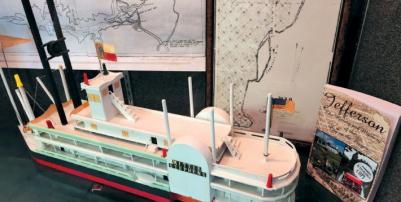The Tragic Tale of the Mittie Stephens

Historic disaster claims dozens of lives
In the mid-1800s, long before the proliferation of automobile travel, steamboats were a common form of transportation in Louisiana. Companies in New Orleans offered steamboat passenger service across Louisiana all the way to the bustling inland port of Jefferson, Texas, and advertising stops at “all intermediate landings on Red River.” Among these stops were Alexandria, Grand Ecore and Shreveport.
 Steamboats reached Shreveport by way of the Red River, but because of the perpetually troublesome Great Raft (which wasn’t completely removed until 1873), river traffic went no farther upriver. Instead, steamboats left the Red River and traveled to Jefferson through the moss-covered catacombs of Cross Lake, Caddo Lake (then called Ferry Lake), Soda Lake and, eventually, Big Cypress Bayou. Because they were caused by back flooding above the Great Raft, the channels were variable seasonal and only navigated using local knowledge and continual water level updates. Despite the difficulties, steamboat traffic to Jefferson was constant, and the city grew accordingly. By 1870, Jefferson was the sixth-largest city in Texas.
Steamboats reached Shreveport by way of the Red River, but because of the perpetually troublesome Great Raft (which wasn’t completely removed until 1873), river traffic went no farther upriver. Instead, steamboats left the Red River and traveled to Jefferson through the moss-covered catacombs of Cross Lake, Caddo Lake (then called Ferry Lake), Soda Lake and, eventually, Big Cypress Bayou. Because they were caused by back flooding above the Great Raft, the channels were variable seasonal and only navigated using local knowledge and continual water level updates. Despite the difficulties, steamboat traffic to Jefferson was constant, and the city grew accordingly. By 1870, Jefferson was the sixth-largest city in Texas.
The steamboat Mittie Stephens routinely made the trip to Jefferson. The boat was a 160-foot long, sidewheel vessel that had served as a troop transport during the Civil War. The boat had previously participated in the Red River Campaign when Union forces tried and failed to seize Shreveport. After the war ended, Mittie Stephens was eventually put to work as a civilian passenger and freight vessel.
Despite its storied past, the steamer Mittie Stephens was destined for a disastrous ending. On Feb. 5, 1869, the doomed steamboat left New Orleans on her final voyage, helmed by Captain Homer Kellogg. After exchanging freight and passengers in Shreveport, the Mittie Stephens departed for Jefferson at 4 p.m. on Feb. 11. More than 100 people were on board.
Later that night, the Mittie Stephens was the unfolding disaster. Upon arriving at the nearing the Texas-Louisiana border (near nightmarish scene, they assisted in rescuing Swanson’s Landing) on Caddo Lake when those who had survived but were left tragedy struck. A spark of flame from the clinging to trees and other debris. giant torches on the front of the ship – used The following days were grim as the to light the way – landed on a hay bale. deceased were accounted for, some washing Within minutes, the Mittie Stephens was ashore later. The burned-out hull of the ablaze. When one of the steersmen sounded steamboat sat smoldering offshore, much to the alarm, Captain Kellogg quickly turned the horror of passengers on subsequent boats the boat toward shore. Sleeping passengers making their way to Jefferson. One such were roused from their slumber. Despite person, Fannie Marchman of New Orleans, frantic efforts by the crew to squelch the fire, recalled coming across the smoldering it raged out of control. wreckage. She had a ticket for the Mittie
As the Mittie Stephens moved toward Stephens but took a different steamboat later the hopeful safety of dry land, the boat only because a child in her party had taken grounded. The large fire near the stern ill, and they had postponed their departure. pushed the frantic passengers toward the Following the tragedy, items of value boat’s aft, which sat in deeper waters. Soon were recovered from the site, including the entire ship was engulfed in flames. the bell, boiler and a safe reputed to carry Terrified passengers leaped into the water. $100,000 in Union payroll. The charred Some unfortunate souls burned, afraid of hull, however, was left behind and remained jumping in the water. Many drowned in the visible from shore for many years. Over murky waters while others were sucked into the years historians, treasure hunters and the still-spinning sidewheels, killing them. A others have studied the Mittie Stephens. lucky few were spared, struggling ashore in The Texas Antiquities Commission took an the dark night. interest in the Mittie Stephens, even though
Captain Kellogg frantically attempted for years it was uncertain on which side of to guide the Mittie Stephens to shore until the state line the steamboat sank. In 1993, the last tragic moments. Abandoning the a marine archaeology crew from Texas ship, he leapt through the flames and fell A&M University returned to Caddo Lake 30 feet to the water below. He survived the to document the supposed site of the Mittie ordeal. In the horrific chaos, more than 60 Stephens’ final resting place. of the 107 passengers and crew were killed. Today, the bell of the Mittie Stephens is on (Exact numbers vary.) In some cases, entire display at the Jefferson Historical Museum families perished. in downtown Jefferson. A large mural on
The steamboat Dixie, moored to a tree the nearby Auntie Skinner’s Riverboat Club about five miles away, witnessed the distant wall also commemorates the tragic tale of fire in the darkness and proceeded toward the Mittie Stephens.
